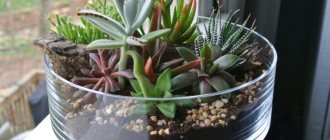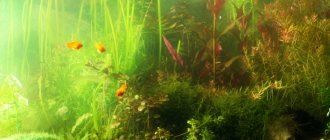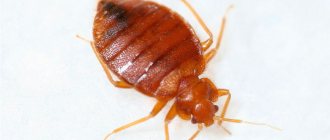When you have fish in your home, you should find out in advance how to clean the aquarium. This seemingly simple activity has its own characteristics and rules that help to restore order in the fish house and not harm its inhabitants. Cleaning is needed not only for beauty, it ensures biological balance, the violation of which leads to irreversible consequences. It is advisable to understand why the water becomes cloudy, what signs indicate the need to clean it, and what daily and general cleaning of the aquarium consists of.
Why does an aquarium get dirty?
Watching the fish calms you down, improves your mood and allows you to promptly notice changes that have occurred in them, indicating that it is time to wash the aquarium. Gradually, the water becomes cloudy, small debris appears in it, and plaque accumulates on the walls, bottom, and soil. These troubles are associated with the life activity of the inhabitants, the presence of algae, and water quality.
The main causes of pollution are the following:
- Overfeeding . If the fish do not eat the food, its remains sink to the bottom and rot.
- Mistakes when decorating . Unprepared soil causes turbidity to appear in the water. Before use, rinse it thoroughly, rinse the shells or figurines used for decoration, and remove fine dust from them.
- Reproduction of microorganisms . Aquarium water necessarily contains bacteria and fungi, which provide benefits by processing ammonia, nitrates and other dangerous substances. But an increase in their number causes a disturbance in the biological balance and the appearance of turbidity. When starting an aquarium, the water needs to be left for several days and only then repopulated.
- Rapid development of algae . This does not mean those plants that sway beautifully and serve as decoration, but lower organisms. They turn the water green and settle on the walls.
- Overcrowding and poor filtration . There are standards regulating the dependence of the number of fish on the volume of water. If there are too many inhabitants, the filter cannot cope, and the amount of waste products increases, causing cloudiness of the liquid.
How to fix it depends on the cause of the problem. You need to analyze the specific situation and decide how to clean the aquarium at home.
How to deep clean an aquarium with restart
Every aquarium needs a restart from time to time. It should not be carried out for prevention. Restarting an aquarium differs from the first start in that it is necessary to first sanitize the container and its contents.
Fish jigging
If the quality of the old aquarium water is sufficient, it is poured into a new container. The fish are transplanted there. Or use water that has been standing for at least two hours.
Important! You need to carefully monitor the behavior of the fish. Stress and changing conditions can cause illness or death.
Removing and washing plants and equipment
Living plants are washed with warm water and placed in a separate container. Filters and compressors are removed and thoroughly washed.
How to clean soil and decorations in an aquarium
To clean decorations in extreme conditions, it is acceptable to use bleach. Things must then be washed thoroughly. It is advisable to use boiling water. The soil is either replaced or processed. Processing consists of thoroughly washing the soil and calcining it in the oven.
Preparing and filling water
Water is prepared in the same way as during scheduled topping up. It is necessary to remember the concentration of various substances and compliance with PH, hardness and salinity.
Putting everything back in place
Starting the aquarium is carried out in the following order:
- Soil is laid out at the bottom.
- Suitable water is poured into the aquarium. The liquid level exceeds the ground level by about 10 cm.
- Plants and decor are placed.
- Equipment is being installed.
- Residents are starting.
- The water level is brought to the usual level in several steps.
- The equipment turns on.
The behavior of the fish must be carefully monitored at first.
We clean an aquarium professionally at home: materials
In all domestic ponds, without exception, a special coating appears on the walls. This makes the glass untidy. To avoid this, algae must be removed. To solve the question of how to clean an aquarium at home, materials such as:
- Plastic scraper equipped with a sharp metal blade. If you don’t have it, you can replace it with regular stationery knives;
- Kitchen sponge;
- Special magnetic tool.
A scraper or a knife purchased at the office is convenient because it removes dirt on glass very well and quickly. If the structure is made of plexiglass, this tool will not work; it will scratch it.
The magnetic tool is ideal for fairly deep containers and those with limited top access. The tool is suitable for modern plexiglass and eliminates the need to drain water before cleaning. The only downside is the overall difficulty in thoroughly cleaning the corners of the container and the edge of the underside of the glass.
The most economical option is to use a standard washcloth, but it forces you to reach all areas with your hand when washing, and its structure is also not suitable for cleaning plexiglass. The algae deposit removed using the selected tool does not need to be caught and then waste time on the cleaning process. The fish will have time to consume a little, and the rest will be removed when drained.
Necessary equipment
It is impossible to properly clean an aquarium without the use of special equipment. To clean the soil you will need aquarium cleaners: a siphon or a special aquarium vacuum cleaner. The choice of cleaner depends on how often the aquarium needs to be cleaned.
To clean the glass from plaque you will need a scraper. The simplest version of this tool is a plastic handle with a metal blade attached to the end. Magnetic scrapers can also be found in pet stores. They are used to clean tanks made of plexiglass and acrylic, because... they do not leave scratches on the material.
Other equipment that may be needed during the cleaning process:
- net;
- bucket or other deep container;
- sponge;
- brush;
- brush;
- rag;
- paper towels.
Cleaning scraper
You can try cleaning vertical surfaces with a scraper. If it is not possible to purchase a special tool for cleaning the bottom of the aquarium, do it yourself. You don't need to use a regular sponge to clean. If the pond is not large in size, a regular razor, pre-attached wire or fishing line of the required length will do.
Specialists use bank cards that are no longer in use to thoroughly clean them. If you don’t want to get your brushes and clothes wet, you can easily attach the card to a wooden base. This tool is efficient and does not scratch at all.
Cleaning the walls
Contamination of glass with bacteria and algae is a natural process, so you should not think that the problem is due to improper fish keeping. Glass that becomes cloudy over time causes discomfort not only to the inhabitants of the aquarium, but also prevents owners from monitoring the lives of their beloved pets.
To remove plaque from the walls, you need to purchase a special scraper. A simpler option involves using a regular sponge, which can be found in every person’s home. When using a magnetic scraper, please note that it does not cope well with dirt in the corners of the aquarium. You can also wash the outside of the glass container. On sale you can find special products adapted for this purpose.
Glass cleaning
Even if your aquarium is sparkling clean and tidy, green deposits will still appear on the walls. Over time, it will begin to increase and ruin the entire aesthetics of the reservoir. To get rid of them, you need to take a scraper (with a blade or a magnetic scraper) or a washcloth. If the depth of your aquarium is acceptable for working with a regular scraper, then go ahead. But there are times when getting to the aquarium from above is a big problem or its depth is very large. In this case, it is best to use a magnetic scraper. It does not scratch glass, only if some grain of sand gets between its working surface. The main disadvantage of such scrapers is that it is difficult to process the lower edge near the ground and corners.
You can also carry out this procedure with a household washcloth, but if your aquarium is made of plexiglass, it is better to put the washcloth aside. There is no need to catch all the algae that you remove from the walls from the aquarium; fish will eat it or it will partially merge with the water.
Scheduled cleaning
Scheduled cleaning of the aquarium is carried out once a week for tanks up to 100 liters, and once every two weeks for larger tanks. This cleaning can be done without transplanting the fish into a separate aquarium.
Washing the walls
To clean the aquarium, turn off all equipment. Take out the internal filters and remove the decor. Using a scraper, the walls are cleared of plaque, which appears even in the most exemplary aquarium. It is recommended to clean the walls of the aquarium with a scraper. They come in two types: magnetic and with a metal blade. You can use a new, household washcloth. A regular metal scraper is not suitable for cleaning plexiglass because it leaves scratches on the surface. In order to clean an aquarium made of such material, use a magnetic scraper. There is no need to specifically remove the removed plaque. It is removed during soil siphoning.
Important: the growth of algae on walls or decor is normal. But only if the growth is moderate. But sometimes the aquarium turns into a swamp in just a few days. This indicates a serious problem with your home pool that needs to be addressed as quickly as possible.
Plant treatment
You need to look after your plants just as carefully as you do indoors. It is necessary to remove rotten leaves or the bushes themselves in a timely manner. Use your fingers to gently remove dirt from large leaves. Overgrown jungles are thinned out to create more space for free swimming. Branches and leaves that have been gnawed by fish or snails are removed. The procedure is carried out as carefully and carefully as possible so as not to raise the turbidity from the bottom. In aquariums where shrimp or capricious fish live, weeding is carried out as rarely as possible. This also applies to nano aquariums, since sap from trimmed plants can spoil the water.
Soil treatment
The soil is cleaned after the walls have been cleaned and the plants have been treated. A siphon is used for this. You need to start from the dirtiest places. I pour the water into a bucket. Care must be taken to ensure that no aquarium inhabitant gets into it. The bottom, corners and seams are treated with a siphon. During soil treatment, part of the water from the aquarium is drained. After the procedure, you need to add fresh water. This process is adding water or changing it.
In herbal aquariums or in pools in which only shrimp live, soil siphoning is not carried out. The fact is that this procedure injures the roots of plants, disrupts the natural balance of the reservoir, and reduces the nutritional properties of the bottom lining.
In general, they siphon the soil as needed. This can be determined by the clouds of turbidity that the inhabitants raise when they touch the bottom, by the presence of escaping bubbles, or by conducting tests.
Cleaning the filter
A weak stream indicates the need to clean the filter. The procedure is carried out once every 1.5 weeks. Wash the filter with extreme caution so as not to destroy the microorganisms that have settled in it. The fact is that these residents participate in biofiltration. The filter can only be washed with aquarium water and without fanaticism. Habitats for microorganisms: sponges, ceramics, balls; they are washed very rarely, approximately once every three months. In general, when washing a filter, it is enough to limit yourself to cleaning the housing, if it is internal equipment, and washing the filter meshes from dirt.
Scenery
Don't forget about the decorations. They also develop a coating of algae. You can wash your jewelry using salt or baking soda and a toothbrush.
Restarting the aquarium
Complete cleaning of the aquarium is a restart. This procedure is carried out when an infection occurs. Before washing the aquarium, all inhabitants are transplanted into another container. If the procedure is carried out urgently, then special tablets are used to stabilize the water in the quarantine area.
An aquarium that has been thoroughly cleaned is not immediately populated. You need to go through all the stages of preparation for moving in. During the time it takes for the microclimate to be established in the cleaned aquarium, the condition of the surviving fish will become clear. The problem is that epidemics do not go away without leaving a trace, and as a rule, a restart threatens a complete renewal of pets.
Cleaning without siphon
In the natural environment, there are a large number of participants in the ecosystem: leftover food and fish excrement are eaten by snails, shrimp and bacteria. But to maintain cleanliness in the aquarium, their owners will have to work hard to properly maintain the fish.
Aquariums should be washed carefully and without sudden movements. Remember, interfering with the underwater world causes stress to its inhabitants.
Cleaning of the soil begins with plants and decorative elements . Large pebbles, shells, houses and castles should be taken out and washed under running water. Plants and algae are carefully inspected for defects. If they have yellowed or rotting leaves, they are carefully removed. When cleaning the bottom of the aquarium, it is better to immediately replant the plants, if necessary.
If you clean the soil without a siphon, you can simply rinse it under running water . In this case, the fish should be transplanted into a separate container (basin, bucket).
This procedure looks like this:
- The soil is taken from the aquarium.
- Pours into a bucket.
- It is washed at maximum pressure until all the dirt is washed out.
- It is best to wear a rubber glove and periodically stir the soil in the bucket.
Helper fish
For additional help in daily cleaning of the aquarium, you can get nurse fish. There are species of fish that feed on unicellular algae, thereby saving the artificial reservoir from unnecessary sedimentation of plaque. However, these pets are only helpers and begin to eat algae only when they feel hungry.
Ancistrus helper fish
In addition to fish, other animals in an artificial reservoir can also perform cleaning functions. Helpers in cleaning an aquarium:
- Gold fish.
- Corridor.
- Viviparous inhabitants.
- Ancistrus (sucker fish).
- Brocade catfish.
- Labeo.
- Gourami.
- Catfish otocinclus.
- Gyrinocheilus.
- Siamese algae eater.
- Snail.
- Shrimps.
Changing the water in the aquarium
After cleaning the inside of the aquarium, you can start changing the water in it. The volume of water changed depends on the degree of contamination. Typically, about 25% of the total water is replaced. The required amount of water for replacement should be drained to clean the soil. The water is drained using a siphon, following the instructions of the device. It is forbidden to use ordinary running water for replacement; it must be settled in advance. It is recommended to pour new water onto a grotto or saucer that has been placed in advance on the substrate, so that the water pressure does not directly hit the ground and damage it.
Preparing replacement water
No more than 30% of its volume can be drained from the tank at a time. Replacing more water is only possible when restarting the aquarium due to illness of its inhabitants or severe disturbances in environmental parameters.
Instead of drained dirty water, clean water is poured. Before this, it must stand for at least a day. Unsettled tap water cannot be used, because... it contains chlorine and other substances toxic to fish. Settling allows you to get rid of most of the impurities.
Cleaning the filter
It is not recommended to wash the internal filter together with other elements of the aquarium, since a sudden change in the biological balance can cause significant harm to the inhabitants of the reservoir. Once a month, the filter can be disassembled and washed using a toothbrush.
Cleaning manipulations should be carried out in such a way as not to harm the beneficial bacteria that have settled on it. They should not be washed thoroughly. The filter elements are lightly washed in water from the aquarium. If the filter has a ceramic filler, it should not be washed more than once a month.
Pollution prevention
To reduce the rate of pollution of a reservoir, its overpopulation should be avoided. You should not overfeed your fish. Uneaten food, when decomposed, releases substances that are poisonous to fish into the water and provokes the growth of algae. Coarse gravel should not be used as soil. Food that falls between the pebbles becomes inaccessible to fish and begins to rot. Planting plants helps to utilize excess organic matter from the soil.
To prevent the growth of algae, you can place freshwater shrimp in the aquarium, which will use them as food. Certain types of fish also cope well with eating algae (for example, the Siamese algae eater). Some types of fish (for example, chain catfish), as well as mollusks, are able to clean the walls and decorations of plaque. You can clean the water in an aquarium from unicellular algae using special algaecide products sold in pet stores.
It is important to use a filter. It not only purifies water from mechanical contaminants, but, along with the soil, is also a habitat for colonies of nitrifying bacteria that convert toxic substances into safe compounds.
Vegetation treatment
If there is living vegetation in an artificial reservoir, then it also requires care and purification. Plants can be cleaned at home, following certain rules:
- Plants do not like transplants.
- Vegetation is not processed during every harvesting operation.
- Spoiled and damaged leaves are cut off.
- Overgrown plants must be removed so that they do not become an obstacle to the free movement of fish.
- Pruning should be done as the bushes grow.
- Overgrown bushes should be thinned out so that they do not interfere with the penetration of light into the container.
- If it is necessary to remove a plant by its roots, the manipulation is carried out as carefully as possible to prevent the rise of turbidity from the substrate.
Getting rid of pests and excess organic matter, restoring the biobalance of the aquarium
Beneficial microelements and harmful algae develop in the vessel. Biobalance is required. In case of deviation, various methods are used:
- launching cleaners (snails, shrimps, fish);
- mechanical cleaning;
- reducing daylight hours to 8 hours;
- adjusting the number of fish;
- vessel restart;
- artificial and living Sera filters;
- purchased preparations to combat algae.
Before using any method, identify the cause of the imbalance in biobalance.
Cleaning the bottom and soil
A lot of waste accumulates at the bottom of the aquarium. To get rid of them, you can use the same hose with a funnel to drain the water, or you can clean it with a special blower with a rubber or glass tip, lowering it to the bottom.
It should be remembered that this is a very powerful device for removing dirt from an aquarium, therefore, you need to be careful with it so that a fish does not inadvertently get sucked into it.
This way the aquarium soil is cleaned of food residues and accumulated debris. Cleaning must be done thoroughly; there is no need to lower and hold the hose in one place; we collect debris around the entire perimeter of the aquarium. This procedure may require replanting the plants, since the entire soil needs to be cleaned, and not a specific part of it.
Many people are interested in: “How to clean the soil in an aquarium” so that cloudiness does not appear in the water?” The answer is simple - no way. In any case, it will settle after we pour clean water into the aquarium and let it settle for a while.
How to clean an aquarium?
To do this you will need a certain set of tools. Detergents are used every few cleanings. In addition, you need clean, fresh water and a container where you can place the aquarium inhabitants and plants.
Aquarium cleaning tools
- First of all, you will need a net. They catch flora and fauna.
Interesting fact: a small net is easier to manipulate in the water, a larger one is easier to catch fish. The choice of net depends on personal convenience.
- To clean the walls you need a special scraper. Different materials require different scrapers; there are separate types for cleaning corners and stubborn dirt. You need a set of several scrapers or a universal tool with interchangeable attachments. This will allow you to achieve better cleanliness and ensure the prevention of various diseases.
- To clean the soil from waste, a siphon is needed. This is a specially designed container with a hose. The soil is scooped up with a siphon, water and waste flow down the hose, and heavier materials remain in place.
- A bucket, preferably several, is used in different ways. Dirty water is poured into it and clean water is poured out of it. You can put fish in it while cleaning. The bucket into which the aquarium is drained should be used only for this purpose, so that toxic substances do not get anywhere else.
Detergents
There is often advice to use bleach or “whiteness”.
Attention! It is prohibited to wash the aquarium itself with them! Getting even a small amount of such products into the water will kill all the fish. Bleach is used in exceptional cases and only for cleaning decorations.
A less dangerous analogue is hydrogen peroxide. The ideal solution is plain water. Only it definitely won’t harm the inhabitants. For particularly difficult stains, boiling water is used.
Baking soda, potassium permanganate, and washing powder solution are used to disinfect the tank.
It is acceptable to use chemical cleaners on the outer walls of the aquarium. The procedure should be performed carefully and carefully. Special napkins for glass and napkins for monitors are also suitable.
How to clean with hydrogen peroxide?
In special situations, it is necessary to use hydrogen peroxide when cleaning the tank. This composition may be required in such situations as:
- Fish diseases.
- Rapid spread of algae.
- Accidental overturning of a can of food.
- One of the fish died, which went unnoticed.
- The filters did not work for a long time.
The use of the composition will saturate the water with a large amount of oxygen. At the same time, oxidation of organic matter will be observed, a large amount of which is quite harmful to the inhabitants of the reservoir.
To achieve a positive effect when using peroxide, you will need to first dilute the composition in a small container, in a ratio of approximately 1:15. It is strictly forbidden to pour pure pharmaceutical composition into the tank; there is a great danger of burning the living inhabitants. The solution is poured from a syringe in a thin stream into the filter, which will gradually release it into the water and produce its beneficial effect.
After about half an hour or an hour, it will be possible to perform a water change to finally remove all elements of dead organic matter that can cause rot.
Tips for care and use
In order for an aquarium with underwater inhabitants to bring exclusively positive emotions to the owner, simple rules should be followed:
- Use only soft, purified water. It will contain few salts, and, as a result, less hardness. This will reduce the amount of limescale deposits. However, water completely devoid of minerals should not be used: fish need the substances in small quantities.
- Buy special supplements at the pet store. They will help reduce calcium content and reduce water hardness. You can periodically dilute distilled water.
- Maintain the filter regularly - it is its condition that guarantees the cleanliness of the aquarium and the health of the fish.
- If the fish shows signs of illness (lethargy, change in behavior, etc.), urgently transfer it to a separate container - this will help avoid an epidemic.
In order for the water to remain clean and clear, the aquarium must be in biological balance. For example, beneficial bacteria break down excrement and food debris. The waste becomes suitable for feeding plants, which, in turn, are able to purify water and release the oxygen necessary for living creatures.
A great way to make cleaning easier and diversify the aquarium population is to have natural “helpers”.
- Shellfish actively fight algae by eating them. In addition, snails clean plaque from the walls.
- Shrimp eat dead parts of plants and absorb algae.
- Some fish feast on algae. They can also be placed in a pond.
An aquarium is a rather complex ecosystem with its own orders. Your task is to maintain the necessary balance. Be careful when settling the aquarium, handle it carefully, and then your home pond will bring you joy.
Cleaning a marine aquarium
If you want to thoroughly clean an ordinary marine tank, which is usually filled with various decorative elements, you will need to follow these rules:
- Decorations can be cleaned inside the aquarium with a stiff brush or outside with a sponge;
- Modern detergents and household cleaners are not used;
- Be sure to remove all algae damaged by crawling snails or fish. You also need to get rid of eaten leaves. The plant should not complicate the movement of aquatic inhabitants;
- If you do not plan to change the water during harvesting, you need to weed out the bushes very carefully, without raising the turbidity.
To save yourself from regular and tedious weeding, you should get special algae-eating fish. They will keep the water clean for a long time. If you use an additional magnet to clean the aquarium, you can get the best option for cleanliness.
If plants grow very quickly, if they acquire a brown tint, this indicates an unfavorable situation in the reservoir. It will be necessary to take certain measures to effectively control lower plant species.
Preparing a new aquarium
Before launching, a new aquarium undergoes the most thorough cleaning. Before washing the container, leave it indoors for several hours. This requirement especially applies to winter purchases. Glass is a fragile material. Brought in from the cold it can easily burst. While the tank is “breathing”, water is prepared that will be poured into the new house. It is left to stand for at least 48 hours so that all the chlorine evaporates.
The next day you can start washing the walls. Before washing a new aquarium, you need to prepare baking soda and a soft sponge. Take a new sponge. Everything is thoroughly cleaned, not forgetting the corners and seams. Rinse thoroughly to remove soda.
Rinse the soil. If the filler was purchased in a store, then simply rinse it. If the soil was collected from a nearby wild body of water, it must be boiled or calcined to destroy possible infection. But it’s better not to take risks and purchase ready-made filler.
Decorative items are also thoroughly washed. For these purposes, use soda or salt. If the decor contains many small details, then an ordinary toothbrush is used for cleaning.
After all the procedures, half of the settled water is poured, soil is placed, plants are planted, and decorative elements are installed. After a day, add the remaining water, not reaching the edge 6 - 10 cm.
The aquarium is left for several days to ensure the integrity of the structure. As soon as the container has passed the leak test, which takes about 5 to 7 days, the water is drained and replaced with a new one. After this, the home pool is forgotten for 2 weeks. During this time, the aquarium begins to establish its own biobalance. After this time, you can release the fish. But not all at once, but gradually. It is important to remember that for the first 1.5 months after the initial start-up, the water is not changed. They just remove rotten plants, do aquarium tests and monitor the condition of the fish.
Which type is better
A siphon is an accessory that is difficult for any aquarium owner to do without. All the inhabitants of the aquarium release their waste products into the environment, the decomposition of which can release rotting products - poisonous gases hydrogen sulfide and ammonia.
Important! These gases are harmful to all living organisms in the aquarium.
If in large natural reservoirs this does not have a significant impact on the health of fish and other animals, then in an aquarium, even a large one, the soil must be regularly cleaned of bottom sediments - fish excrement and silt. In this way, you can clean the filler in the form of sand, pebbles, black types and other varieties.
With pump
The aquarium siphon is very simple. It usually consists of a hose with an extension at the end and a pump with a check valve. As a rule, inexpensive siphons consisting of a bulb equipped with inlet and outlet valves and a corrugated hose do the best job. This type is perfect for a small aquarium due to the replaceable end of the hose.
Battery operated
There are electric siphons that run on batteries. They are equipped with a small electric pump that sucks in water. Such siphons eliminate the need to pump water manually. It is most advisable to use them for owners of large aquariums that require a lot of time to clean manually.
Homemade
You can make a siphon for an aquarium yourself quite easily and cheaply. All you need for this is a flexible hose and a plastic bottle. The thicker the siphon hose, the more water it will draw in per second.
Advice! Select the thickness of the hose based on the volume of your aquarium.
For example, for a 100-liter aquarium, a siphon with a hose 1 cm thick is well suited; for an aquarium of a smaller volume, a correspondingly thinner hose is suitable.
To make your own siphon, cut off the top narrow part of the bottle to create a funnel, and then attach one end of the hose to the neck. To work with such a siphon, you need to place its funnel in water and draw air from the other end of the hose to create draft. Usually, the manufacture of such a siphon does not justify itself - fortunately, full-fledged siphons are available on the market at quite affordable prices.
Can I use household chemicals?
Fish and aquatic plants are sensitive to the composition of water, so chemical detergents are not used when cleaning the aquarium.
An exception may be decorative items, but even here it is better to use mechanical processing. As a last resort, use baking soda or bleach. Then the elements are thoroughly washed with running water.
Sometimes detergents are recommended for treating new aquariums. It is also better to refuse this. Dust and dirt are removed using running water and a regular sponge.
Mr. Tail recommends: how to clean an aquarium without removing the fish
During weekly and scheduled cleaning of the aquarium, an important question arises about the safety of its inhabitants. After all, cleaning is carried out without removing the fish from the tank.
To do this, do the following:
- The compress and filters are turned off, taken out of the aquarium and washed carefully, usually using a toothbrush.
- Using a scraper, quickly remove the green coating from the walls of the tank, immediately picking it up with a sponge. You should try not to let it fall into the water.
- Drain the water - a third, a half, a quarter. Pour in clean, settled water.
- Connect clean and washed equipment - pump, aeration unit, lighting, lid.
- For all procedures, you can use a special mesh, blocking the tank and keeping the fish in the safest zone.











